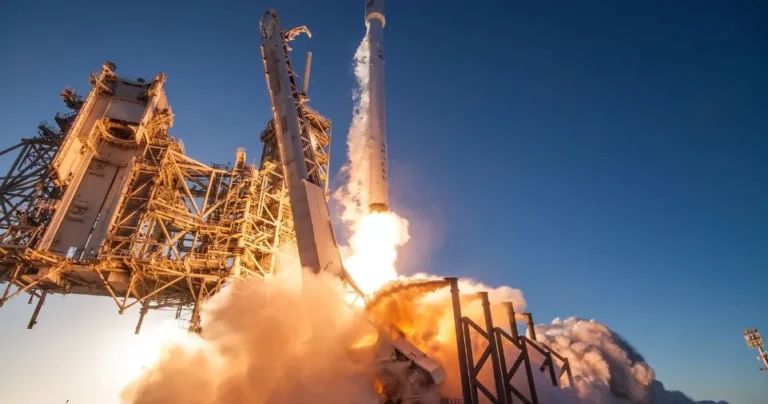SpaceX rockets launched a whopping 525 of the world’s 626 spacecraft sent up during the first quarter of the year — exponentially blowing past the next-best entities, China Aerospace Science and Technology Corp. (27 spacecraft) and Russia’s Roscosmos (24 spacecraft).
In a related comparison, SpaceX launched spacecraft weighing about 429,125 kilograms during the first quarter, which extended from Jan. 1 to March 31. That dwarfed CASC’s 29,426 kilograms and Roscosmos’ 23,782 kilograms.
“The takeaways are really not altogether surprising, right? SpaceX is the lead. China’s in second. And then, there’s a whole bunch that follow,” said Phil Smith, a BryceTech space industry analyst.
BryceTech, which compiled the first-quarter statistics, is an Alexandria, Virginia-based analytics firm that provides launch industry data to the Federal Aviation Administration Office of Commercial Space Transportation.
As of Thursday, 45 Florida orbital launches have taken flight this year from NASA’s Kennedy Space Center and Cape Canaveral Space Force Station — establishing a cadence that would easily surpass last year’s annual record of 72 rocket launches.
SpaceX has accounted for 43 of those 45 launches. United Launch Alliance launched the other two rockets: the first Vulcan on its Jan. 8 certification mission and the last Delta IV Heavy on the April 9 NROL-70 mission.
“It’s really impressive what (SpaceX) can do. I mean, I remember not that long ago when it was impressive that a company could launch 10 times in a year,” Smith said.
Why so many launches? “SpaceX is moving right along with its Starlink deployment,” Smith said. In a tweet last week, Starlink officials announced their ever-growing high-speed internet network is now available in Sierra Leone, the 100th country, territory or other market served around the world.
As of Thursday, June 13, 6,079 Starlink satellites were functioning in low-Earth orbit, according to Jonathan McDowell, an astrophysicist at the Harvard–Smithsonian Center for Astrophysics.
“Roughly half have been deployed. The constellation that got approved has 12,000 satellites. And then the long-term plan is to have 40,000. So, still got a ways to go in that regard,” Smith said.
‘Smallsat’ statistical breakdown
Last year, rockets around the world launched 2,860 “smallsats” weighing 1,200 kilograms or lighter, BryceTech reported. A peek behind the numbers:
- Communications satellites comprised 79% of that total, with remote sensing (13%), technology development (7%) and scientific (1%) applications accounting for nearly all the rest.
- SpaceX and OneWeb accounted for 2,116 of those smallsats, while all other companies and entities accounted for the other 744.
- Smallsats comprised 97% of all spacecraft launched during 2023.
Regarding the 2,860-smallsat total, Smith predicted that this year will see an increase over that figure.
“Final 9, another launch! Shortly before a Falcon 9 launched 22 more Starlink internet-beaming satellites into low-Earth orbit from Cape Canaveral Space Force Station, SpaceX founder and CEO Elon Musk tweeted on June 7. “Falcon alone is trending to set a world record for the most amount of mass Earth delivers to orbit in a year.”
ALSO READ:
Massive SpaceX Starship to launch in future
Upping the ante, SpaceX proposes to soon launch its Starship-Super Heavy two-stage mega-rocket from KSC. SpaceX officials also hope to start sending up the massive launch system by 2026 at Cape Canaveral Space Force Station.
The FAA and U.S. Air Force are preparing Starship environmental impact statements in tandem with NASA, the Coast Guard and other federal agencies. Starship remains under development, and the fourth test flight lifted off June 6 from Boca Chica, Texas.
“It’s this transitional phase that we’re seeing there for SpaceX between Falcon 9, Falcon Heavy and Starship. And the Falcons aren’t going anywhere anytime soon, we speculate,” Smith said.
“Because there’s a lot of customer interest in that vehicle. It’s extremely reliable. And the price is right. So I don’t think that we would see the Falcon 9 going anywhere until the Starship is very much routinely used. And that’ll be a while,” he said.
Meanwhile, Amazon officials aim to launch half of the company’s planned 3,236-satellite Project Kuiper broadband satellite constellation by July 2026, an Amazon vice president said during a National Space Club Florida Committee speech last month.
Hiring is underway for Amazon’s $120 million satellite processing facility, which is under construction at KSC’s Launch and Landing facility.







